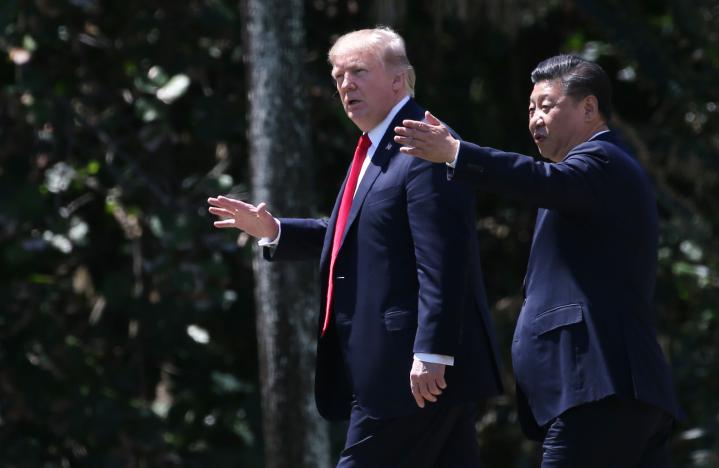Florida – The rapid action in Syria could be interpreted as a signal of President Trump’s willingness to use military force especially to North Korea and its ally China, as well as other countries like Iran and Russia. This comes as North Korea is developing missiles capable of hitting the United States.
During the second day of the Chinese-US summit in Florida, US, Chinese President Xi Jinping said that he agreed with Trump that North Korea’s nuclear advancement had reached a critical stage.
As for the Terminal High Altitude Area Defense (THAAD), South Korea issued a statement saying that President Donald Trump explained US’s position on the deployment of a US-supplied anti-missile defence to China’s President Xi in their summit meeting.
In addition, Trump informed South Korean Prime Minister Hwang Kyo Ahn of his discussions with the Chinese President during a telephone call on Saturday.
China strongly opposes the deployment of the THAAD in South Korea which Washington and Seoul say is aimed at countering North Korea’s missile threat.
Reuters reported the US Secretary of State Rex Tillerson saying that Xi had agreed to increased cooperation in “reining in North Korea’s missile and nuclear programs”. Yet, the Chinese president didn’t offer any new formula for cracking Pyongyang’s defiant attitude.
Xinhua China’s official news agency said Xi had encouraged the United States to take part in the “One Belt, One Road” plan, Xi’s signature foreign policy imitative aimed at infrastructure development across Asia, Africa and Europe.
Some policy circles see Xi’s plan as a partial answer to the pivot to Asia strategy of Trump’s predecessor Barack Obama.
Trump mentioned the two leaders had achieved progress in several issues, and so did their aides, but no one had provided details other than that the two had agreed to find common ground for cooperation.
As the two leaders ended their Florida summit which was overshadowed by US missile strikes in Syria, Xi joined Trump in stressing the positive mood of the meetings while papering over deep differences that have caused friction between the world’s two biggest economies.
Trump’s aides insisted he had made good on his pledge to raise concerns about China’s trade practices and said there was some headway, with Xi agreeing to a 100-day plan for trade talks aimed at boosting US exports and reducing China’s trade surplus with the United States.
During his presidential campaign, Trump had promised to stop what he called the “theft of American jobs by China”. Those who had helped Trump with his unexpected election victory, are pressuring him to deliver that promise.
The Republican president tweeted last week that the United States could no longer tolerate massive trade deficits and job losses and that his meeting with Xi “will be a very difficult one.”
On Friday, the unpredictable Trump not only set a different tone but also avoided any public lapses in protocol that Chinese officials had feared could embarrass their leader.
During the joint press conference, Trump told the press that they made tremendous progress in US’ relationship with China. “We will be making additional progress. The relationship developed by President Xi and myself I think is outstanding,” he added without giving further information.
Xi also spoke in mostly positive terms saying: “We have engaged in deeper understanding, and have built a trust.”
“I believe we will keep developing in a stable way to form friendly relations … For the peace and stability of the world, we will also fulfill our historical responsibility,” he stated to which Trump responded: “I agree with you 100 percent.”
Xi lauded the military exchanges between the two countries saying they both should benefit from the dialogue mechanism that is supposed to be set between US and Chinese Chief of Staffs.
Tillerson afterwards described the discussions as “very frank and candid.”
“President Trump and President Xi agreed to work in concert to expand areas of cooperation while managing differences based on mutual respect,” he said.
TRAVEL BAN
In other matters, the American Civil Liberties Union (ALCU) argued in papers filed to the court that State Department had internal instructions to implement Trump’s temporary travel ban on citizens of six Muslim-majority nations. ALCU said that these instructions help demonstrate that the ban violates the constitution.
ACLU made the argument as part of its lawsuit in federal court in the Northern District of California on behalf of three student visa holders against Trump’s March 6 executive order.
The order prevents travelers from Iran, Libya, Somalia, Sudan, Syria and Yemen from entering the United States for 90 days and refugees for four months.
The lawsuit, which seeks class-action status, says the order discriminates against Muslims.
Tillerson issued instructions to implement Trump’s order in a series of four cables to consular officers worldwide last month, which were first revealed by Reuters.
ACLU pointed that the language of one of the cables directs consular officers to assess whether applicants from the six countries “found otherwise eligible” for US visas could still be denied visas based on Trump’s order.
The ACLU said the guidance “amounts to an unconstitutional amendment of existing law.”
A State Department official declined to comment on the litigation or the cables and so did the Department of Justice.
